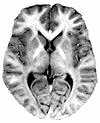Neuroscience for Kids Consultant
August 19, 2002
Human language and its representation in the brain have fascinated scientists for many years. Progress has been made in identifying important language areas in the brain, such as Broca's and Wernicke's areas. Most research has focused on people who speak only one language. However, some researchers have become interested in the brains of people who have learned a second language. Many questions remain unanswered about the similarities and differences between first and second language learning, storage, and usage.
Substantial evidence suggests the existence of a critical learning period for first languages. A critical period for language is defined as the time period during which a person must be exposed to the spoken language in order to best learn the language. In most cases, if a person is not exposed to a language during the critical period, he or she will never be able to speak the language as well as someone who learned language normally. Although the person may be able to learn many vocabulary words, his or her syntax will probably never reach a normal level.
Children who have brain damage are often able to regain their language abilities with practice. Adults, however, who suffer damage to language areas are rarely able to achieve their previous language proficiency. This observation further supports the concept that there might be a difference between learning language in childhood and adulthood. Although it is generally believed that a critical period exists for a first language, it is not known if there is a similar critical period for a second language. For example, if your first language is English, when must you start to learn Spanish, Russian, or Mandarin to be able to learn it completely? What is it about the brain that allows -- and perhaps requires -- us to learn languages at a young age?
Research suggests that learning second (or third) languages is easier for young children, and some evidence indicates certain brain areas that might be involved in this learning. Several studies have related second language learning to Broca's and Wernicke's areas. In these studies, researchers compared brain function in people who spoke two languages (bilinguals) and who learned both languages early in life with brain activity of bilinguals who learned one of their languages after puberty. Early bilinguals were found to use very similar, overlapping regions of Broca's and Wernicke's areas for both languages. Late bilinguals also used overlapping regions of Wernicke's area for both languages, but they normally used different, though adjacent, regions of Broca's area for each language.

Wernicke's Area

Images courtesy of
Slice of Life.
 Many studies suggest that the age at which a second language is learned
may determine whether brain areas used for processing each language are
overlapping or different. Early bilinguals seem more likely to use
overlapping brain areas and late bilinguals seem more likely to use
different areas for each language. Some studies have also suggested that
late bilinguals are more likely to use the same cortical areas for
understanding
what the words mean (Wernicke's) but different areas for grammar and
syntax (Broca's). Most researchers, however, emphasize that this is
probably a simplified way of looking at things. It is important to
remember that the brain areas that show activity during language
use may not necessarily be the areas where language is stored. These
areas could be used for processing or even for producing speech sounds.
Practical experience tells many people that children do seem better suited
to picking up new languages, but additional research is needed before we
know exactly why.
Many studies suggest that the age at which a second language is learned
may determine whether brain areas used for processing each language are
overlapping or different. Early bilinguals seem more likely to use
overlapping brain areas and late bilinguals seem more likely to use
different areas for each language. Some studies have also suggested that
late bilinguals are more likely to use the same cortical areas for
understanding
what the words mean (Wernicke's) but different areas for grammar and
syntax (Broca's). Most researchers, however, emphasize that this is
probably a simplified way of looking at things. It is important to
remember that the brain areas that show activity during language
use may not necessarily be the areas where language is stored. These
areas could be used for processing or even for producing speech sounds.
Practical experience tells many people that children do seem better suited
to picking up new languages, but additional research is needed before we
know exactly why.Information about language acquisition could be useful in determining better strategies for learning second (or third or fourth...) languages. Additionally, knowledge of the brain areas involved in language processing will almost certainly be important during neurosurgery. Surgeons need to know which brain areas are involved in language comprehension and production, so that they will not disturb these valuable centers during operations on the brain.
 For
references and more information, see:
For
references and more information, see:![[email]](./gif/menue.gif)

